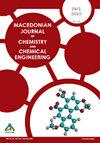二甲基铵碘化铅包晶石的合成、表征和伏安研究
IF 1.1
4区 化学
Q3 CHEMISTRY, MULTIDISCIPLINARY
Macedonian Journal of Chemistry and Chemical Engineering
Pub Date : 2024-05-20
DOI:10.20450/mjcce.2024.2861
引用次数: 0
摘要
近十年来,研究最多的包晶材料是有机-无机混合包晶(HOIPs),因为它们具有光电特性,并可能应用于光伏生产。这种兴趣促使我们不断寻找新的 HOIP 变体,同时对现有 HOIP 的特性进行深入研究。因此,我们在有机-无机包覆晶石领域的研究旨在合成、表征二甲基碘化铅铵(DMAPbI3),并利用伏安法研究其电化学特性。DMAPbI3 的改良合成方法与文献中描述的方法略有不同,它是将等量的碘化铅(PbI2)和二甲基碘化铵(DMAI)溶于乙腈中。在进行受控蒸发后,得到了黄色结晶粉末 DMAPbI3。粉末 X 射线衍射(PXRD)、红外(IR)和拉曼光谱以及扫描电子显微镜(SEM)和能量色散 X 射线光谱(EDX)证实了所获化合物的特性和纯度。以二氯甲烷(DCM)和四丁基氯化铵(TBAC)为电解质,通过循环伏安法对 DMAPbI3 的电化学特性进行了研究。使用石蜡浸渍石墨电极(PIGE)作为工作电极,并在其上固定了包晶微粒。DMAPbI3 的电化学活性可通过一个强烈、宽广且不可逆的阳极峰来识别,该阳极峰是由于成分氧化成不同的可能产物以及包晶结构的分解而产生的。本文章由计算机程序翻译,如有差异,请以英文原文为准。
Synthesis, characterisation and voltammetric study of dimethylammonium lead iodide perovskite
In the last decade, the most investigated perovskite materials are the hybrid organic-inorganic perovskites (HOIPs) due to their optoelectronic properties and possible application in the production of photovoltaics. This interest has led to an ongoing search for new HOIP variants, alongside thorough investigations of the properties of existing HOIPs. That is why our research in the field of organic-inorganic perovskites is aimed at the synthesis, characterization, and investigation of the electrochemical properties of dimethylammonium lead iodide (DMAPbI3) using voltammetric studies. A modified synthesis of DMAPbI3, differing slightly from the one described in the literature, was performed by combining stoichiometric amounts of lead iodide (PbI2) and dimethylammonium iodide (DMAI) dissolved in acetonitrile. After conducting controlled evaporation, a yellow crystalline powder of DMAPbI3 was obtained. The identity and purity of the obtained compound were confirmed by powder X-ray diffraction (PXRD), infrared (IR) and Raman spectroscopy, and scanning electron microscopy (SEM) with energy dispersive X-ray spectroscopy (EDX). Investigations on the electrochemical properties of DMAPbI3 by cyclic voltammetry were performed with dichloromethane (DCM) and tetrabutylammonium chloride (TBAC) as the electrolyte. A paraffin-impregnated graphite electrode (PIGE) was used as a working electrode, on which the perovskite microparticles were immobilized. The electrochemical activity of DMAPbI3 is recognized through an intense, broad, and irreversible anodic peak attributed to the oxidation of the constituents to different possible products and the decomposition of the perovskite structure.
求助全文
通过发布文献求助,成功后即可免费获取论文全文。
去求助
来源期刊
CiteScore
1.60
自引率
20.00%
发文量
14
审稿时长
>12 weeks
期刊介绍:
Macedonian Journal of Chemistry and Chemical Engineering (Maced. J. Chem. Chem. Eng.) is an official publication of the Society of Chemists and Technologists of Macedonia. It is a not-for-profit open acess journal published twice a year. The journal publishes original scientific papers, short communications, reviews and educational papers from all fields of chemistry, chemical engineering, food technology, biotechnology and material sciences, metallurgy and related fields. The papers published in the Journal are summarized in Chemical Abstracts.

 求助内容:
求助内容: 应助结果提醒方式:
应助结果提醒方式:


